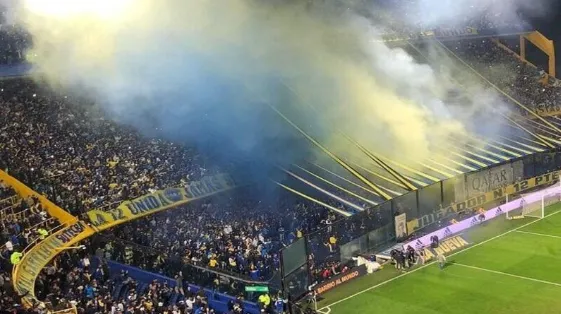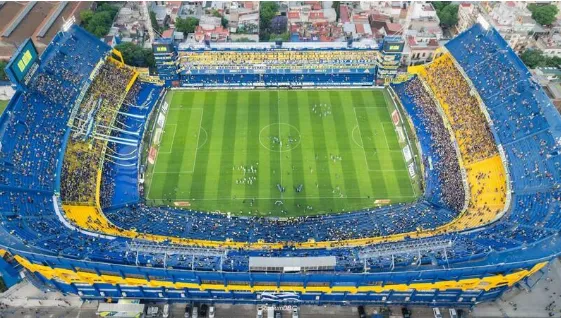La Bombonera’s roar echoes through Buenos Aires, a living monument to passion, identity, and spectacle in football. From its steep terraces to its deep roots in the La Boca neighborhood, this stadium remains a temple for Boca Juniors fans and a pilgrimage site for football lovers worldwide.
More than steel and seats: La Bombonera’s identity
La Bombonera is more than a football venue. Its distinctive architecture, emotional weight, and deep connection with community make it one of the most iconic stadiums in the sport.

A design that amplifies noise
The stadium’s structure is unusual. It’s built with three steep sides and one flat wall, making the sound bounce back toward the pitch. Fans are positioned close to the action, which turns every chant into an overwhelming wave of noise. This design is not just functional—it’s intimidating.
Because of this layout, players often describe the experience as playing inside a drum. The sound is constant and deafening, with chants echoing off concrete walls. It’s part of what gives Boca Juniors such a formidable home advantage.
Football, class, and La Boca’s heart
Located in the colorful but modest district of La Boca, La Bombonera grew alongside the people. Boca Juniors was founded by Italian immigrants and quickly became a symbol of working-class pride in Buenos Aires. The stadium, too, became part of this identity.
It represents more than a club. For many residents, it is the cultural and emotional core of the neighborhood. It has seen joy, political marches, community events, and decades of triumph and tension. In this place, football is not entertainment—it is identity.
Matchday rituals and the fan experience
On matchday, the streets around the stadium come alive early. Vendors sell blue and yellow merchandise, local drummers lead parades, and supporters fill nearby murals with new symbols. Entering the stadium feels like stepping into a different world.
Inside, a section known as La Doce leads the charge. The group of hardcore supporters sings non-stop, creating the soundtrack of the game. Their presence is relentless. Even during warm-ups, the energy feels like a final. Every match, regardless of the opponent, is treated like a must-win.
It’s no coincidence that many describe La Bombonera as a sacred ground. The experience of watching football here is raw and immersive. In a digital age, it feels wonderfully analog.
This kind of intensity mirrors how 90phut TV World Cup matches with Vietnamese commentators bring global football closer to fans at home. Like the fans in La Bombonera, Vietnamese viewers live every moment through sound, emotion, and community spirit.
The theatre of legends and rivalry
Beyond the structure and the fans lies the soul of football history. La Bombonera has witnessed generations of greatness and fierce rivalries that define South American football.

Moments etched into its walls
Dozens of iconic matches have taken place here. Title deciders, Copa Libertadores thrillers, and league-defining games are woven into the cement. The stadium seems to hold onto memories. Every scratch on the wall and every crack in the steps tells a story.
Players talk about how the stadium feels like it’s watching you. When Boca wins at home, the celebration isn’t just about goals—it’s about history continuing. Defeats feel heavier here too. The pressure is always present.
Icons made and mythologized
Some of Argentina’s most revered footballers found their home in this stadium. Diego Maradona began and ended his domestic career with Boca Juniors, treating La Bombonera as his theatre. Juan Román Riquelme orchestrated games with grace, turning matches into art. Carlos Tevez, a product of the neighborhood, played like every game was his last.
These legends didn’t just play here—they shaped its personality. Their influence is seen in graffiti, fan chants, and even the way young players carry themselves on the pitch. The stadium makes icons and then keeps their legacy alive.
Superclásico’s raw intensity
When River Plate comes to visit, the stadium changes completely. The Superclásico between Boca Juniors and River Plate is among the fiercest rivalries in the world. The buildup is filled with media speculation, tactical debates, and emotional tension.
On the day of the match, no one is calm. The noise, the pressure, and the emotions are magnified. Every tackle is cheered or booed like a goal. Players often talk about how it’s the most difficult environment they’ve ever played in.
Even before these matches, fans rely on 90phut expert opinion before big matches to analyze formations, expectations, and momentum—because in environments like La Bombonera, every small edge matters.
Preservation of soul in a changing era
While many stadiums around the world have become modern, sanitized arenas, La Bombonera has held onto its soul.
Modernization vs authenticity
Proposals have come and gone, aiming to expand capacity or replace the stadium entirely. But every attempt is met with resistance. Supporters do not want luxury boxes if it means losing the intimacy and spirit that defines their home.
While parts of the infrastructure have been improved, the core remains unchanged. The concrete still carries history. The wooden benches still creak with stories. And that’s the way fans want it to stay.
Negotiating renovation and tradition
Plans have been made to increase seating and make structural changes, but these ideas face political and cultural hurdles. La Bombonera isn’t just a place to watch football—it’s a cultural heritage site.
Balancing safety, comfort, and tradition is difficult. Some fans would prefer to see no changes at all. Others agree with small upgrades as long as the stadium never loses its character. What unites them all is the desire to protect what makes it special.
Cultural symbolism beyond sport
The stadium has become a symbol in music, art, and literature. It appears in tango lyrics, political posters, and even educational campaigns. Around the stadium, murals show legends, slogans, and images of fans. It has outgrown football and become a national icon.
Visitors from around the world come to La Bombonera not just for a match, but to experience what football feels like when it’s pure and personal.
Conclusion
La Bombonera remains a heartbeat of football in Argentina. With its steep stands, relentless fans, and unforgettable atmosphere, it represents something timeless. While the world changes, this stadium proves that football is still best when it is loud, local, and full of love.